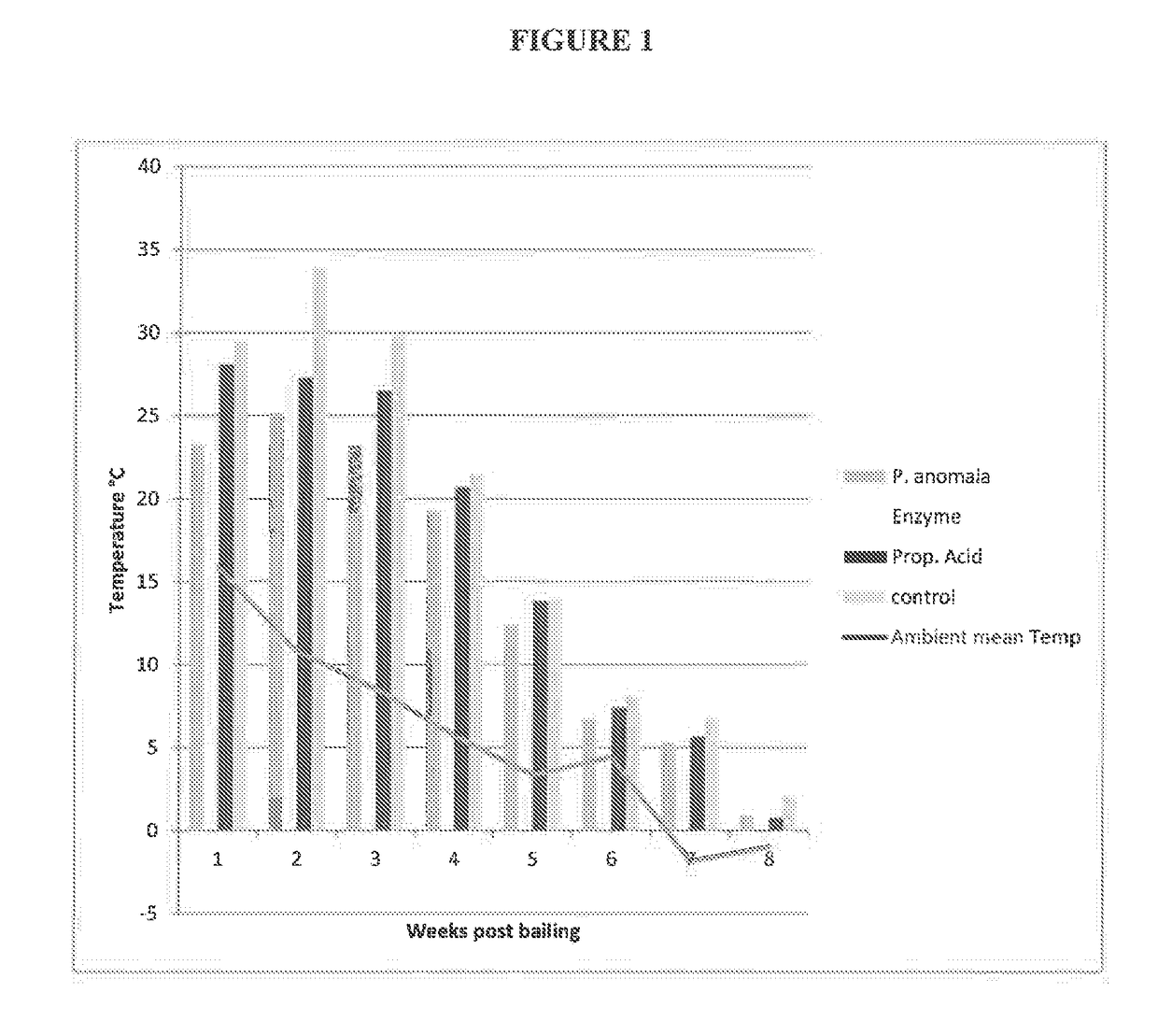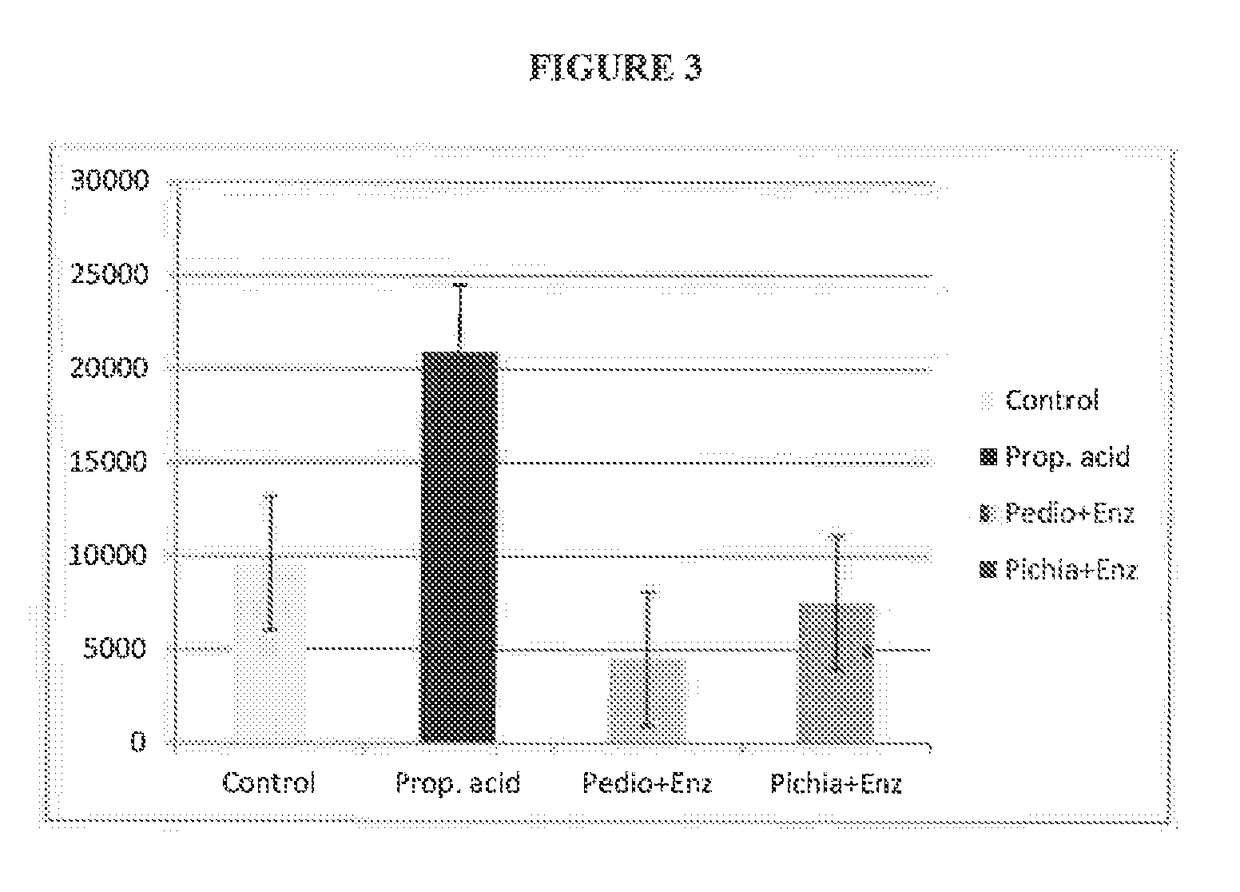Hay preservative and methods for preservation of hay
a technology of hay and preservative, which is applied in the field of hay preservative, can solve the problems of increasing the field, affecting and reducing the nutritive quality of hay, so as to reduce the heat of high-moisture hay equally or better, and preserve the quality of hay
- Summary
- Abstract
- Description
- Claims
- Application Information
AI Technical Summary
Benefits of technology
Problems solved by technology
Method used
Image
Examples
example 1
[0041]Hay, Treatments and Baling Conditions
[0042]The hay was a third-cut consisting of 90% alfalfa and 10% brome grass. The hay was cut with a New-Holland™ disc-bine on Sep. 17, 2011 and left to dry unconditioned and undisturbed. Moisture level was evaluated using a Farmex™ windrow hay moisture tester (1205 Danner Drive, Aurora, Ohio) five days after cutting and found to be ranging from 20 to 35%. At this time the hay preservatives were prepared by pre-weighing inoculants and mixing each of them into separate jugs containing 6.5 L of pre-measured distilled water and shaken for 1 minute. A sprayer tank and spray boom with a single nozzle was mounted onto a 4790 Hesston big square baler. The boom was placed such that the spray pattern covered 90% of the windrow with minimal drifting.
[0043]Two trial bales were made to determine time to complete application of the additive on one bale, weight of the bale as well as a more accurate measure of moisture content of the baled material. Bale ...
example 2
[0060]Hay, treatments and baling conditions
[0061]The hay was alfalfa hay and was harvested on Aug. 15, 2012 at Fort Macleod, Alberta, Canada. The alfalfa hay was wilted in field to moisture levels between about 24% and about 30%. Bale moisture was determined as in Example 1.
[0062]The application rate of the combination of P. anomala in combination with the enzyme having a chitinase activity was respectively 1011 CFU and 1.5 g in 1 L of water per ton of hay. Accordingly, the application rate of the combination of P. pentosaceus in combination with the enzyme having a chitinase activity 1011 CFU and 1.5 g in 1 L of water per ton of hay. Propionic acid product consisted of 68% (vol / vol) propionic acid, and was applied at a rate of 2.72 L / ton and considered as a positive control. The negative control was water, and was applied at a rate of 1 L per ton of hay. Five large round bales of about 800 kg were made in accordance with Example 1 for each treatment on the same day. Core samples fr...
example 3
[0078]This examples shows that the enzyme having a chitinase activity is even further enhanced from the standpoint of its preservative effect and its capacity in preventing and / or reducing heat damage on high moisture hay if the at least one enzyme having a chitinase activity is combined with a yeast of the genus Pichia or bacteria of the genus Pediococcus. The hay was harvested and wilted in field to moisture levels as in example 2.
[0079]The application rate of the combination of P. anomala in combination with the enzyme having a chitinase activity was respectively 1011 CFU and 1.5 g in 1 L of water per ton of hay. Accordingly, the application rate of the combination of P. pentosaceus in combination with the enzyme having a chitinase activity 1011 CFU and 1.5 g in 1 L of water per ton of hay. The application rate of P. anomala alone was 1011 CFU in 1 L per ton of hay. The application rate of P. pentosaceus alone was 1011 CFU in 1 L per ton of hay. The enzyme having a chitinase acti...
PUM
| Property | Measurement | Unit |
|---|---|---|
| temperature | aaaaa | aaaaa |
| pH | aaaaa | aaaaa |
| weight | aaaaa | aaaaa |
Abstract
Description
Claims
Application Information
 Login to View More
Login to View More - R&D
- Intellectual Property
- Life Sciences
- Materials
- Tech Scout
- Unparalleled Data Quality
- Higher Quality Content
- 60% Fewer Hallucinations
Browse by: Latest US Patents, China's latest patents, Technical Efficacy Thesaurus, Application Domain, Technology Topic, Popular Technical Reports.
© 2025 PatSnap. All rights reserved.Legal|Privacy policy|Modern Slavery Act Transparency Statement|Sitemap|About US| Contact US: help@patsnap.com



